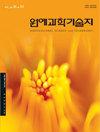基于品质属性和贮藏温度的“皇家盛会”苹果保质期预测
IF 0.8
4区 农林科学
Q3 HORTICULTURE
Korean Journal of Horticultural Science & Technology
Pub Date : 2021-06-01
DOI:10.7235/HORT.20210031
引用次数: 4
摘要
采后苹果品质性状恶化引起的表型变化造成了巨大的经济损失。因此,迫切需要准确预测苹果保质期的策略。2016年至2018年连续三年,新鲜收获的“皇家盛会”苹果分别储存在0、5、15和25°C的温度下。随后,以周期性间隔测量11个质量属性,直到存储结束。为了筛选更少、更有用的索引,考虑了三个输入数据集:温度、颜色值(L*、a*、b*,△E、 和C*)、重量损失、硬度、可滴定酸度、可溶性固体含量、淀粉和还原性抗坏血酸(D1)。采用稀疏主成分分析(SPCA)(D2)和相关分析(CA)(D3),以保质期为输出层,对基于反向传播(BP-ANN)模型的人工神经网络进行关键质量属性筛选。结果表明,D1、D2和D3的预测和测量保质期的相关系数(r)分别为0.996、0.997和0.993,而平均相对误差分别为0.071、0.074和0.074。同时,相对均方根百分比(RMS)值分别为0.088、0.092和0.112。SPCA的应用将输入数据集的质量属性从12个减少到6个。因此,SPCA-BP人工神经网络被证明是一个准确预测“皇家加拉”苹果采后保质期的有用模型。附加关键词:人工神经网络,相关性分析,模型,稀疏主成分分析,存储本文章由计算机程序翻译,如有差异,请以英文原文为准。
Shelf Life Prediction of ‘Royal Gala’ Apples Based on Quality Attributes and Storage Temperature
Phenotypic changes caused by postharvest deterioration of the quality attributes of apples cause substantial economic losses. Thus, strategies for accurate prediction of the shelf life of apples is urgently needed. In each of the three consecutive years from 2016 to 2018, freshly harvested ‘Royal Gala’ apples were stored at 0, 5, 15, and 25°C, respectively. Subsequently, 11 quality attributes were measured at periodic intervals until the end of storage. To screen fewer and more useful indexes, three input datasets were considered: temperature, color value (L*, a*, b*, △E, and C*), weight loss, firmness, titratable acidity, soluble solids content, starch, and reducing ascorbic acid (D1). The key quality attributes were screened by sparse principal component analysis (SPCA) (D2) and correlation analysis (CA) (D3), using shelf life as the output layer of the artificial neural network based on the back propagation (BP ANN) model. The results showed that the correlation coefficients (r) of the predicted and measured shelf life for D1, D2, and D3 were 0.996, 0.997, and 0.993, respectively, while the mean relative errors were 0.071, 0.074, and 0.074, respectively. Meanwhile, the relative percent root mean square (RMS) values were 0.088, 0.092, and 0.112, respectively. The application of SPCA reduced the quality attributes for the input dataset from 12 to 6. Therefore, SPCA-BP ANN was shown to be a useful model for accurate prediction of the postharvest shelf life of ‘Royal Gala’ apples. Additional key words: artificial neural network, correlation analysis, model, sparse principal component analysis, storage
求助全文
通过发布文献求助,成功后即可免费获取论文全文。
去求助
来源期刊
CiteScore
2.00
自引率
0.00%
发文量
0
审稿时长
1 months
期刊介绍:
Horticultural Science and Technology (abbr. Hortic. Sci. Technol., herein ‘HST’; ISSN, 1226-8763), one of the two official journals of the Korean Society for Horticultural Science (KSHS), was launched in 1998 to provides scientific and professional publication on technology and sciences of horticultural area. As an international journal, HST is published in English and Korean, bimonthly on the last day of even number months, and indexed in ‘SCIE’, ‘SCOPUS’ and ‘CABI’. The HST is devoted for the publication of technical and academic papers and review articles on such arears as cultivation physiology, protected horticulture, postharvest technology, genetics and breeding, tissue culture and biotechnology, and other related to vegetables, fruit, ornamental, and herbal plants.

 求助内容:
求助内容: 应助结果提醒方式:
应助结果提醒方式:


